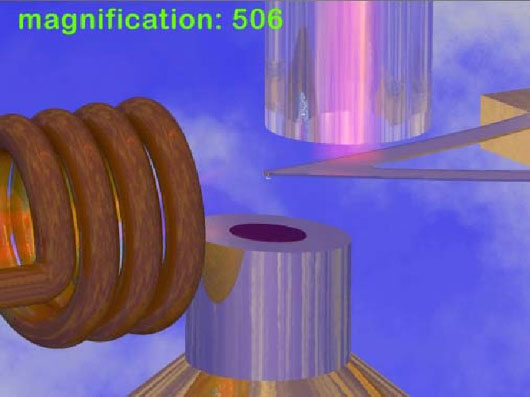|
Magnetic Resonance Force Microscopy (MRFM) Magnetic resonance force microscopy (MRFM) is an imaging technique that combines atomic force microscopy (AFM) and magnetic resonance imaging (MRI) with the possibility of non-destructively achieving true 3-D sub-surface imaging at atomic resolution and chemical specificity. A molecule whose structure is to be determined (~200nm, too small to be seen to scale by the eye in this picture) is placed below a sharp magnetic tip. The magnetic tip is attached to a sensitive micromechanical cantilever that will bend in response to small forces, including the magnetic forces due to the magnetic nuclei in the sample. Nuclear magnetic resonance is used to manipulate individual nuclei that are just the right distance from the tip (i.e., within the "resonant slice"). By applying a suitably modulated radiofrequency (rf) magnetic field using a small coil, the magnetic moment of the nucleus within the resonant slice can be flipped up, down, up, down, etc., thus generating an alternating force on the tip that causes the cantilever to vibrate slightly. This vibration is detected using a sensitive fiber-optic interferometer. By scanning the sample with respect to the tip in a three-dimensional raster pattern, an image of the atomic structure of the molecule can, in principle, be obtained. Image Courtesy of Dr. John A Sidles,University of Washington, Seattle, WA. Grant 8 RO1 EB02018_11 Image courtesy of Dr. John A Sidles, University of Washington, Seattle, WA. Grant 8 RO1 EB02018_11
|
 |
 |
Department of Health and Human Services |
 |
National Institutes of Health |
 |




